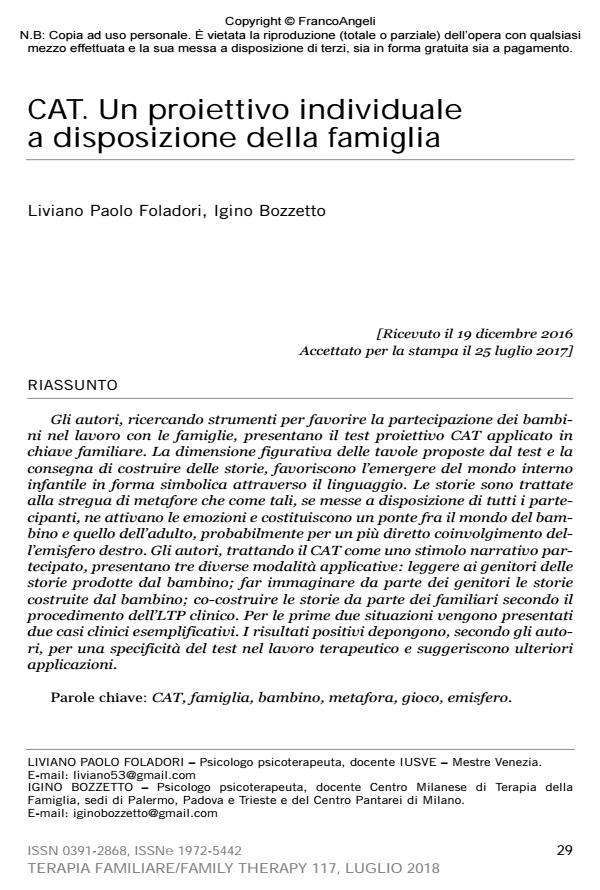CAT. A individual projective available to the family
Journal title TERAPIA FAMILIARE
Author/s Liviano Paolo Foladori, Igino Bozzetto
Publishing Year 2018 Issue 2018/117 Language Italian
Pages 16 P. 29-44 File size 101 KB
DOI 10.3280/TF2018-117003
DOI is like a bar code for intellectual property: to have more infomation
click here
Below, you can see the article first page
If you want to buy this article in PDF format, you can do it, following the instructions to buy download credits

FrancoAngeli is member of Publishers International Linking Association, Inc (PILA), a not-for-profit association which run the CrossRef service enabling links to and from online scholarly content.
The authors, with the intention to find instruments to support children’s participation when working with families, present the projective CAT test in a familiar-applicated way. The figurative dimension typical of this test and the task to build some narrations, support the rise of the children’s internal world in a symbolical way through the language. Narrations are used as if they were metaphors and, once made available to all the presents, will activate their feelings and build a bridge between the chil- dish and the adult world, probably because of a major and direct involvement of the right hemisphere. The authors, reporting to the CAT as a narrative, participative incentive, present three different applicative procedures: reading to the parents their chil- dren’s narrations; allowing the parents to imagine what children’s narrations could be; allowing the relatives to co-build the narrations following the LTP cli- nical procedure. In the first two situations, two clinical, exemplifying cases will be presented. The positive results, according to the authors, give evidence to the specificity of this test in the therapeutic work and suggest further applications.
Keywords: CAT, family, child, metaphor, game, hemisphere.
- Bandler R., Grinder J. (1975). I modelli delle tecniche ipnotiche di Milton Erickson, vol. I. Roma: Astrolabio, 1985.
- Bateson G. (1972). Verso un’ecologia della mente. Milano: Adelphi, 1997.
- Bellak L., Bellak S.S. (1949). Test di appercezione per fanciulli CAT e del sup- plemento CAT – S. Manuale di istruzioni. Firenze: Organizzazioni Speciali, 1981.
- Bercelli F., Leonardi P., Viaro M. (1999). Cornici Terapeutiche. Applicazioni cliniche di analisi dell’interazione verbale. Milano: Raffaello Cortina.
- Boekholt M. (1996). La diagnosi nella clinica infantile. Milano: Raffaello Cortina.
- Caillé P., Rey Y. (2004). Les objets flottants, méthodologie systémique de la relation d’aide. Paris: Fabert Edition.
- Chabert C. (1980). Contenu manifeste et contenu latent au Children’s Apperception Test (CAT). Psycologie Française, 25 (2): 115-124.
- Cigoli V., Tamanza G. (2009). L’intervista clinica generazionale. Milano: Raffaello Cortina.
- Danesi M. (1998). Il cervello in aula – Neurolinguistica e didattica delle lingue. Perugia: Guerra Edizioni.
- de Bernart R. (1989). Tecniche relazionali con la famiglia e con l’individuo. Terapia Familiare, 31: 85-92.
- Erickson M., Rossi E. (1982-84). Opere, vol. I. Roma: Astrolabio.
- Fivaz-Depeursinge E., Corboz-Warnery A. (2000). Il Triangolo Primario. Milano: Raffaello Cortina.
- Giusti E., Azzi L. (2013). Neuroscienze per la psicoterapia. La clinica dell’integra- zione trasformativa. Roma: Sovera.
- Jaynes J. (1976). L’origine della coscienza dal crollo della mente bicamerale. Milano: Adelphi, 1984.
- Leporatti C. (2011). Fuochi nell’ombra. Uso di immagini d’arte in psicoterapia indi- viduale e di coppia ad orientamento sistemico-relazionale. In: Chianura P., Chianura I., Fuxa E., Mazzoni S. (a cura di), Manuale Clinico di Terapia Familiare. Vol III. Metodi e strumenti per la valutazione dei processi relazio- nali. Milano: FrancoAngeli, pp. 179-200.
- Lurija A. (1973). Come lavora il cervello. Bologna: Il Mulino.
- Kasparian K. (2013). Hemispheric differences in figurative language processing: Contributions of neuroimaging methods and challenges in reconciling current empirical findings. Journal of Neurolinguistics, 26: 1-21. journal homepage: www.elsevier.com/locate/jneuroling
- Malagoli Togliatti M., Mazzoni S. (2006). Osservare, valutare e sostenere la rela- zione genitori-figli, Il Lausanne Trilogue Play clinico. Milano: Raffaello Cortina. Ortony A. (1980). Metaphor and thought. Cambridge: Cambridge University Press.
- Pelletier K. (1978). Toward a Science of Consciousness. New York: Delta.
- Sperry R.W. (1968). Hemispheric deconnection and unit in conscious awareness.
- American Psychologist, 23: 723-733.
- Tressoldi P.E., Barilani C., Pedrabissi L. (2004). Lo stato (preoccupante) delle tecni- che proiettive per l’età evolutiva in Italia. Psicologia Clinica dello Sviluppo, 1: 9- 28. DOI: 10.1449/1317
- Watzlawick P. (1975). Il Linguaggio del Cambiamento. Milano: Feltrinelli.
- Weiser J. (1999). Fototerapia. Metodologia e applicazioni cliniche. Milano: FrancoAngeli.
- Winnicott D. (1974). Gioco e realtà. Roma: Armando.
Liviano Paolo Foladori, Igino Bozzetto, CAT. Un proiettivo individuale a disposizione della famiglia in "TERAPIA FAMILIARE" 117/2018, pp 29-44, DOI: 10.3280/TF2018-117003